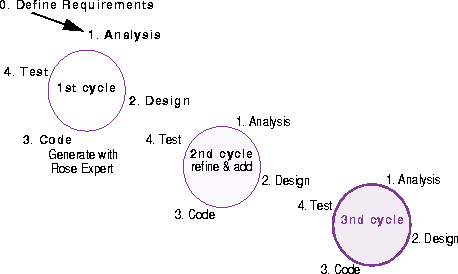Generally, you will cycle through the last four steps several times as shown in Figure 2-1.
Figure 2-1 Iterative Nature of the Objected Oriented Development Process

You can employ object-oriented development methods that incorporate UML concepts and also provide you with an iterative, procedural framework within which to work.
For detailed information on object-oriented development processes, refer to the list of publications in the section Rose Expert Development Related Information. Of particular interest in this context is the approach called Object Oriented Software Engineering (OOSE) because of the focus on use case models as a leading principle in development.
Here, we review the generic object-oriented development process.
In general, the object-oriented development process tends to be iterative. That is, you develop an application in successive stages-each time getting closer to the ideal. First you develop a core application-an initial prototype. Then you refine the prototype, improving and extending it. Depending on the complexity of the application, you may go through many cycles or iterations.
This process usually consists of the following phases, wherein you begin at a high level of abstraction and get progressively more specific in describing the system you want to build:
Generally, you will cycle through the last four steps several times as shown in Figure 2-1.
Figure 2-1 Iterative Nature of the Objected Oriented Development Process
